BCD Arithmetic | Project Report
VerifiedAdded on 2022/09/18
|6
|1310
|56
AI Summary
Contribute Materials
Your contribution can guide someone’s learning journey. Share your
documents today.
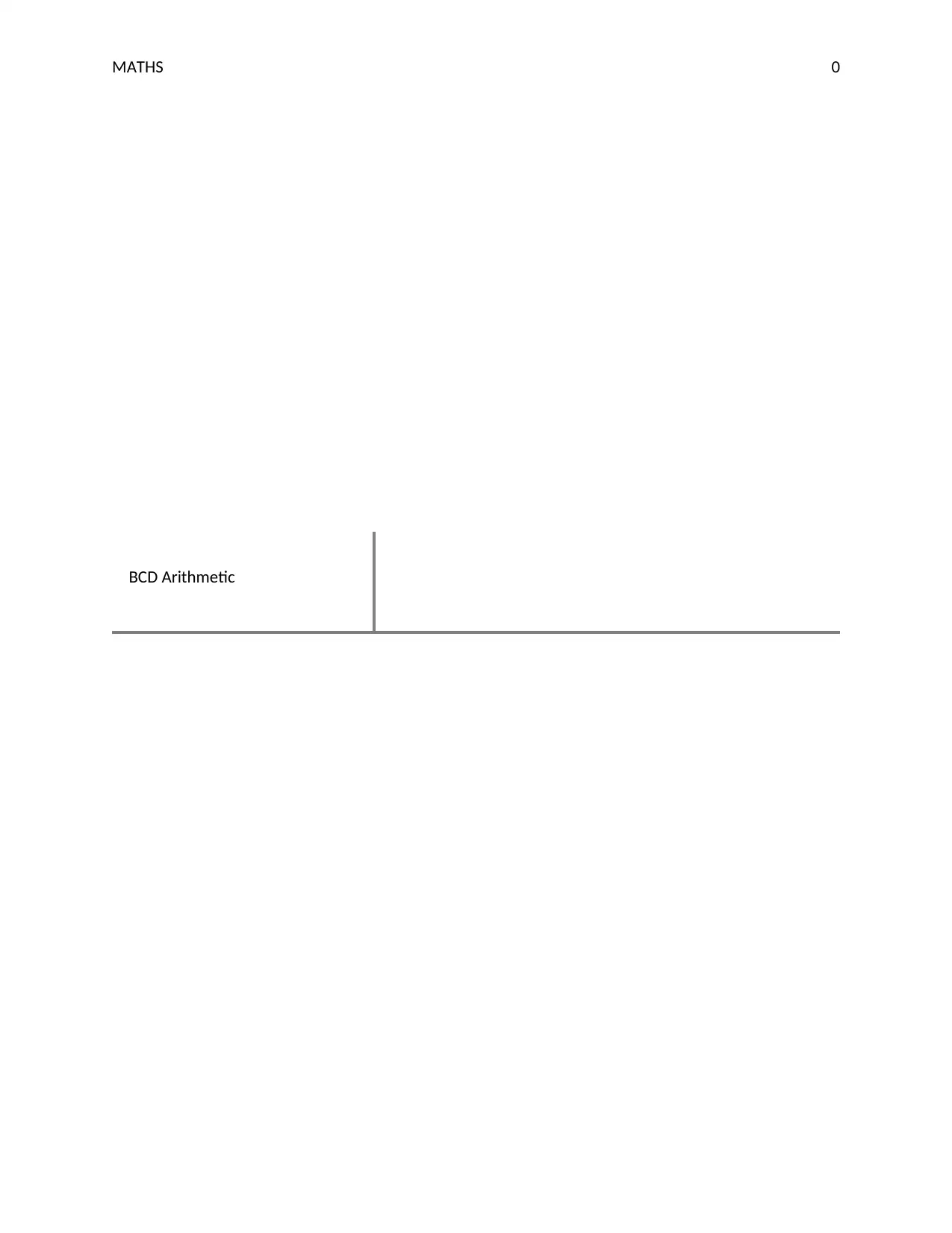
MATHS 0
BCD Arithmetic
BCD Arithmetic
Secure Best Marks with AI Grader
Need help grading? Try our AI Grader for instant feedback on your assignments.
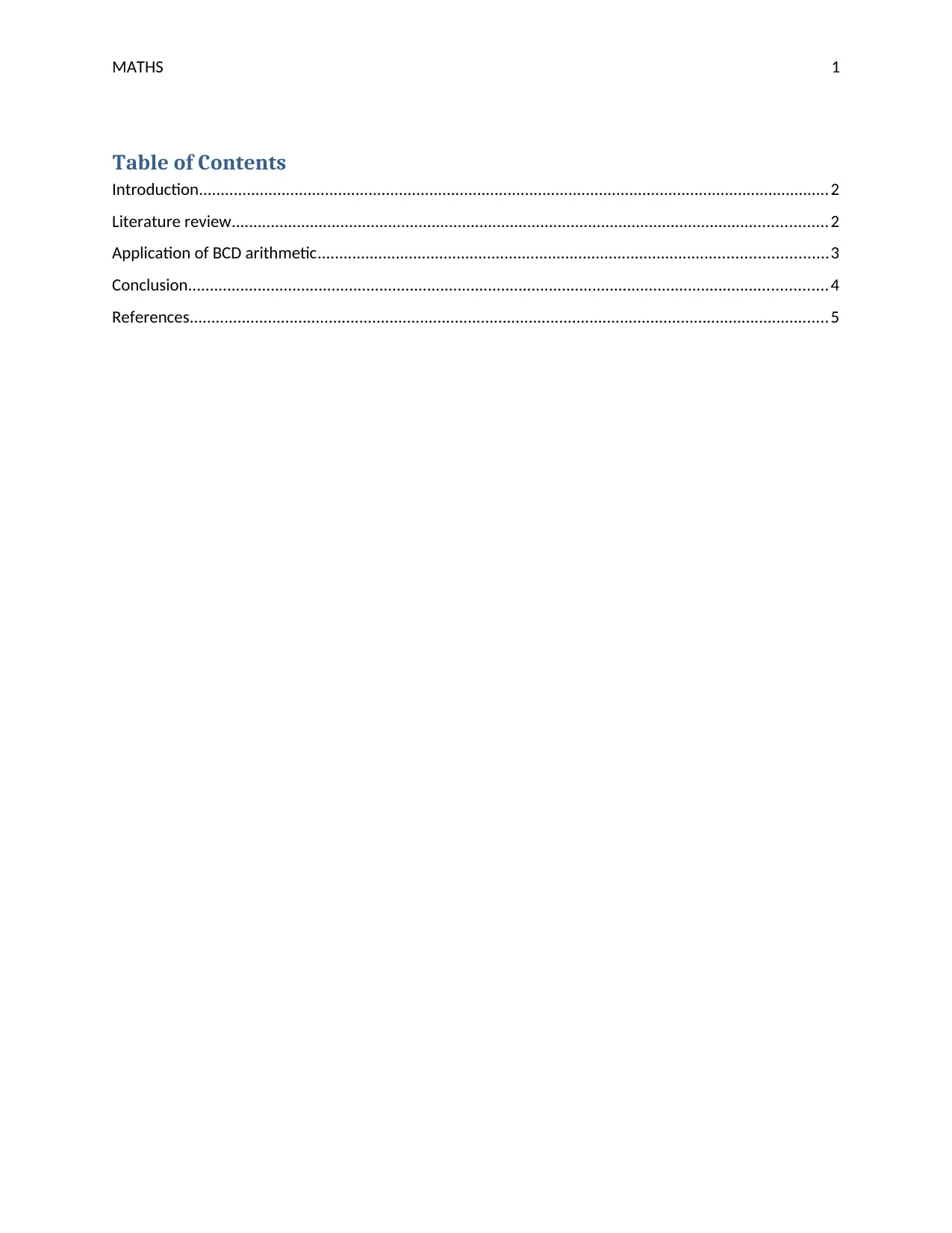
MATHS 1
Table of Contents
Introduction.................................................................................................................................................2
Literature review.........................................................................................................................................2
Application of BCD arithmetic.....................................................................................................................3
Conclusion...................................................................................................................................................4
References...................................................................................................................................................5
Table of Contents
Introduction.................................................................................................................................................2
Literature review.........................................................................................................................................2
Application of BCD arithmetic.....................................................................................................................3
Conclusion...................................................................................................................................................4
References...................................................................................................................................................5
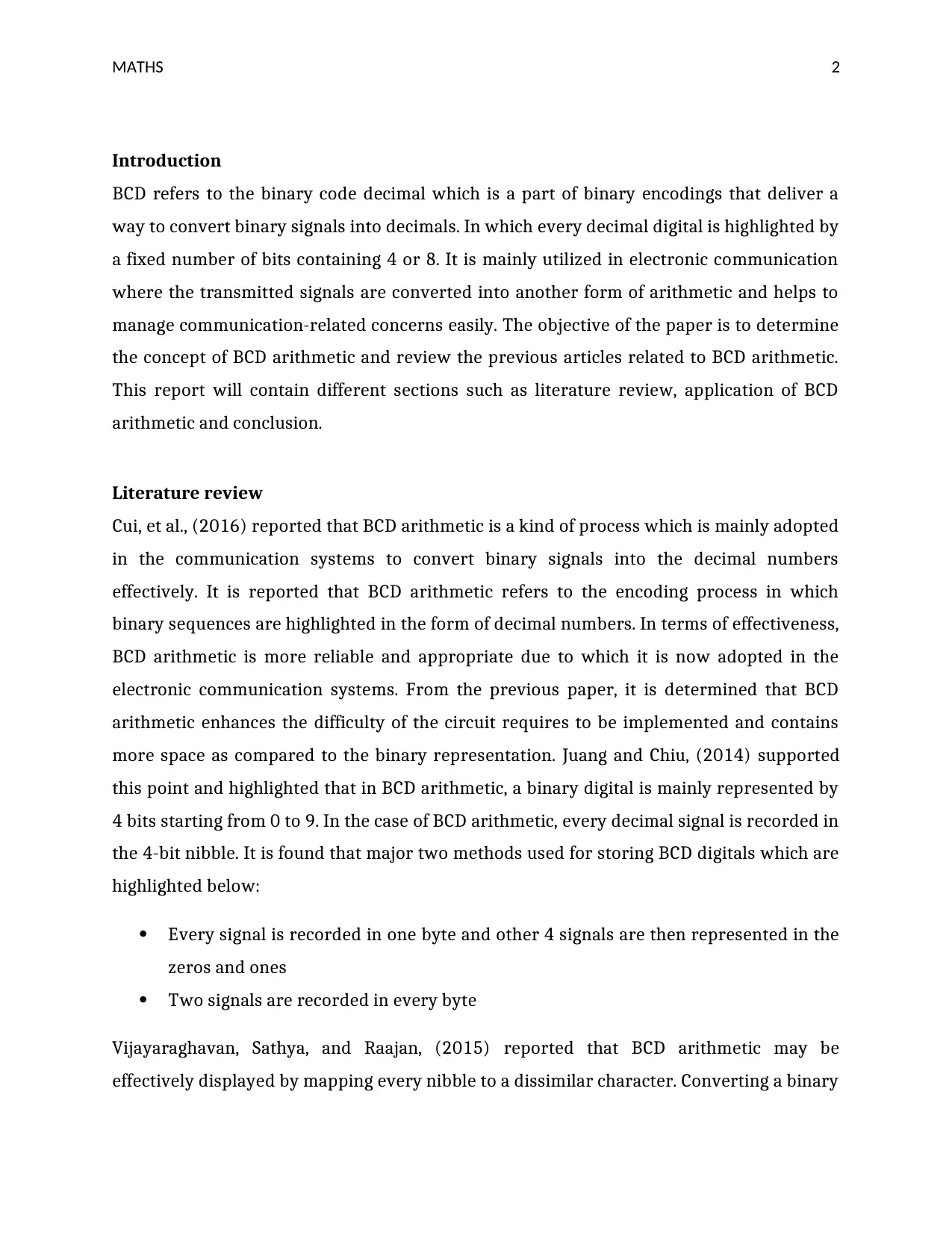
MATHS 2
Introduction
BCD refers to the binary code decimal which is a part of binary encodings that deliver a
way to convert binary signals into decimals. In which every decimal digital is highlighted by
a fixed number of bits containing 4 or 8. It is mainly utilized in electronic communication
where the transmitted signals are converted into another form of arithmetic and helps to
manage communication-related concerns easily. The objective of the paper is to determine
the concept of BCD arithmetic and review the previous articles related to BCD arithmetic.
This report will contain different sections such as literature review, application of BCD
arithmetic and conclusion.
Literature review
Cui, et al., (2016) reported that BCD arithmetic is a kind of process which is mainly adopted
in the communication systems to convert binary signals into the decimal numbers
effectively. It is reported that BCD arithmetic refers to the encoding process in which
binary sequences are highlighted in the form of decimal numbers. In terms of effectiveness,
BCD arithmetic is more reliable and appropriate due to which it is now adopted in the
electronic communication systems. From the previous paper, it is determined that BCD
arithmetic enhances the difficulty of the circuit requires to be implemented and contains
more space as compared to the binary representation. Juang and Chiu, (2014) supported
this point and highlighted that in BCD arithmetic, a binary digital is mainly represented by
4 bits starting from 0 to 9. In the case of BCD arithmetic, every decimal signal is recorded in
the 4-bit nibble. It is found that major two methods used for storing BCD digitals which are
highlighted below:
Every signal is recorded in one byte and other 4 signals are then represented in the
zeros and ones
Two signals are recorded in every byte
Vijayaraghavan, Sathya, and Raajan, (2015) reported that BCD arithmetic may be
effectively displayed by mapping every nibble to a dissimilar character. Converting a binary
Introduction
BCD refers to the binary code decimal which is a part of binary encodings that deliver a
way to convert binary signals into decimals. In which every decimal digital is highlighted by
a fixed number of bits containing 4 or 8. It is mainly utilized in electronic communication
where the transmitted signals are converted into another form of arithmetic and helps to
manage communication-related concerns easily. The objective of the paper is to determine
the concept of BCD arithmetic and review the previous articles related to BCD arithmetic.
This report will contain different sections such as literature review, application of BCD
arithmetic and conclusion.
Literature review
Cui, et al., (2016) reported that BCD arithmetic is a kind of process which is mainly adopted
in the communication systems to convert binary signals into the decimal numbers
effectively. It is reported that BCD arithmetic refers to the encoding process in which
binary sequences are highlighted in the form of decimal numbers. In terms of effectiveness,
BCD arithmetic is more reliable and appropriate due to which it is now adopted in the
electronic communication systems. From the previous paper, it is determined that BCD
arithmetic enhances the difficulty of the circuit requires to be implemented and contains
more space as compared to the binary representation. Juang and Chiu, (2014) supported
this point and highlighted that in BCD arithmetic, a binary digital is mainly represented by
4 bits starting from 0 to 9. In the case of BCD arithmetic, every decimal signal is recorded in
the 4-bit nibble. It is found that major two methods used for storing BCD digitals which are
highlighted below:
Every signal is recorded in one byte and other 4 signals are then represented in the
zeros and ones
Two signals are recorded in every byte
Vijayaraghavan, Sathya, and Raajan, (2015) reported that BCD arithmetic may be
effectively displayed by mapping every nibble to a dissimilar character. Converting a binary
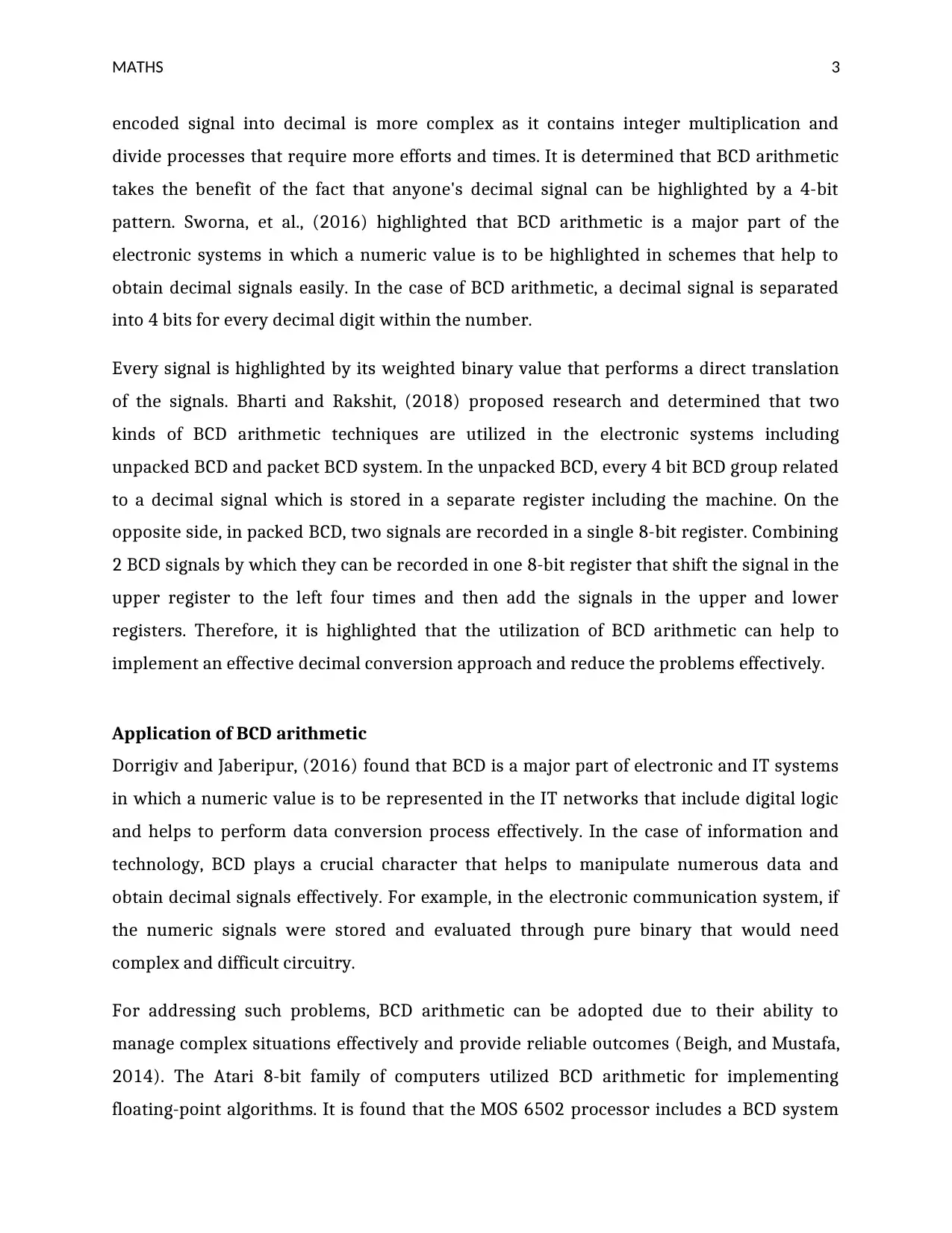
MATHS 3
encoded signal into decimal is more complex as it contains integer multiplication and
divide processes that require more efforts and times. It is determined that BCD arithmetic
takes the benefit of the fact that anyone's decimal signal can be highlighted by a 4-bit
pattern. Sworna, et al., (2016) highlighted that BCD arithmetic is a major part of the
electronic systems in which a numeric value is to be highlighted in schemes that help to
obtain decimal signals easily. In the case of BCD arithmetic, a decimal signal is separated
into 4 bits for every decimal digit within the number.
Every signal is highlighted by its weighted binary value that performs a direct translation
of the signals. Bharti and Rakshit, (2018) proposed research and determined that two
kinds of BCD arithmetic techniques are utilized in the electronic systems including
unpacked BCD and packet BCD system. In the unpacked BCD, every 4 bit BCD group related
to a decimal signal which is stored in a separate register including the machine. On the
opposite side, in packed BCD, two signals are recorded in a single 8-bit register. Combining
2 BCD signals by which they can be recorded in one 8-bit register that shift the signal in the
upper register to the left four times and then add the signals in the upper and lower
registers. Therefore, it is highlighted that the utilization of BCD arithmetic can help to
implement an effective decimal conversion approach and reduce the problems effectively.
Application of BCD arithmetic
Dorrigiv and Jaberipur, (2016) found that BCD is a major part of electronic and IT systems
in which a numeric value is to be represented in the IT networks that include digital logic
and helps to perform data conversion process effectively. In the case of information and
technology, BCD plays a crucial character that helps to manipulate numerous data and
obtain decimal signals effectively. For example, in the electronic communication system, if
the numeric signals were stored and evaluated through pure binary that would need
complex and difficult circuitry.
For addressing such problems, BCD arithmetic can be adopted due to their ability to
manage complex situations effectively and provide reliable outcomes (Beigh, and Mustafa,
2014). The Atari 8-bit family of computers utilized BCD arithmetic for implementing
floating-point algorithms. It is found that the MOS 6502 processor includes a BCD system
encoded signal into decimal is more complex as it contains integer multiplication and
divide processes that require more efforts and times. It is determined that BCD arithmetic
takes the benefit of the fact that anyone's decimal signal can be highlighted by a 4-bit
pattern. Sworna, et al., (2016) highlighted that BCD arithmetic is a major part of the
electronic systems in which a numeric value is to be highlighted in schemes that help to
obtain decimal signals easily. In the case of BCD arithmetic, a decimal signal is separated
into 4 bits for every decimal digit within the number.
Every signal is highlighted by its weighted binary value that performs a direct translation
of the signals. Bharti and Rakshit, (2018) proposed research and determined that two
kinds of BCD arithmetic techniques are utilized in the electronic systems including
unpacked BCD and packet BCD system. In the unpacked BCD, every 4 bit BCD group related
to a decimal signal which is stored in a separate register including the machine. On the
opposite side, in packed BCD, two signals are recorded in a single 8-bit register. Combining
2 BCD signals by which they can be recorded in one 8-bit register that shift the signal in the
upper register to the left four times and then add the signals in the upper and lower
registers. Therefore, it is highlighted that the utilization of BCD arithmetic can help to
implement an effective decimal conversion approach and reduce the problems effectively.
Application of BCD arithmetic
Dorrigiv and Jaberipur, (2016) found that BCD is a major part of electronic and IT systems
in which a numeric value is to be represented in the IT networks that include digital logic
and helps to perform data conversion process effectively. In the case of information and
technology, BCD plays a crucial character that helps to manipulate numerous data and
obtain decimal signals effectively. For example, in the electronic communication system, if
the numeric signals were stored and evaluated through pure binary that would need
complex and difficult circuitry.
For addressing such problems, BCD arithmetic can be adopted due to their ability to
manage complex situations effectively and provide reliable outcomes (Beigh, and Mustafa,
2014). The Atari 8-bit family of computers utilized BCD arithmetic for implementing
floating-point algorithms. It is found that the MOS 6502 processor includes a BCD system
Secure Best Marks with AI Grader
Need help grading? Try our AI Grader for instant feedback on your assignments.
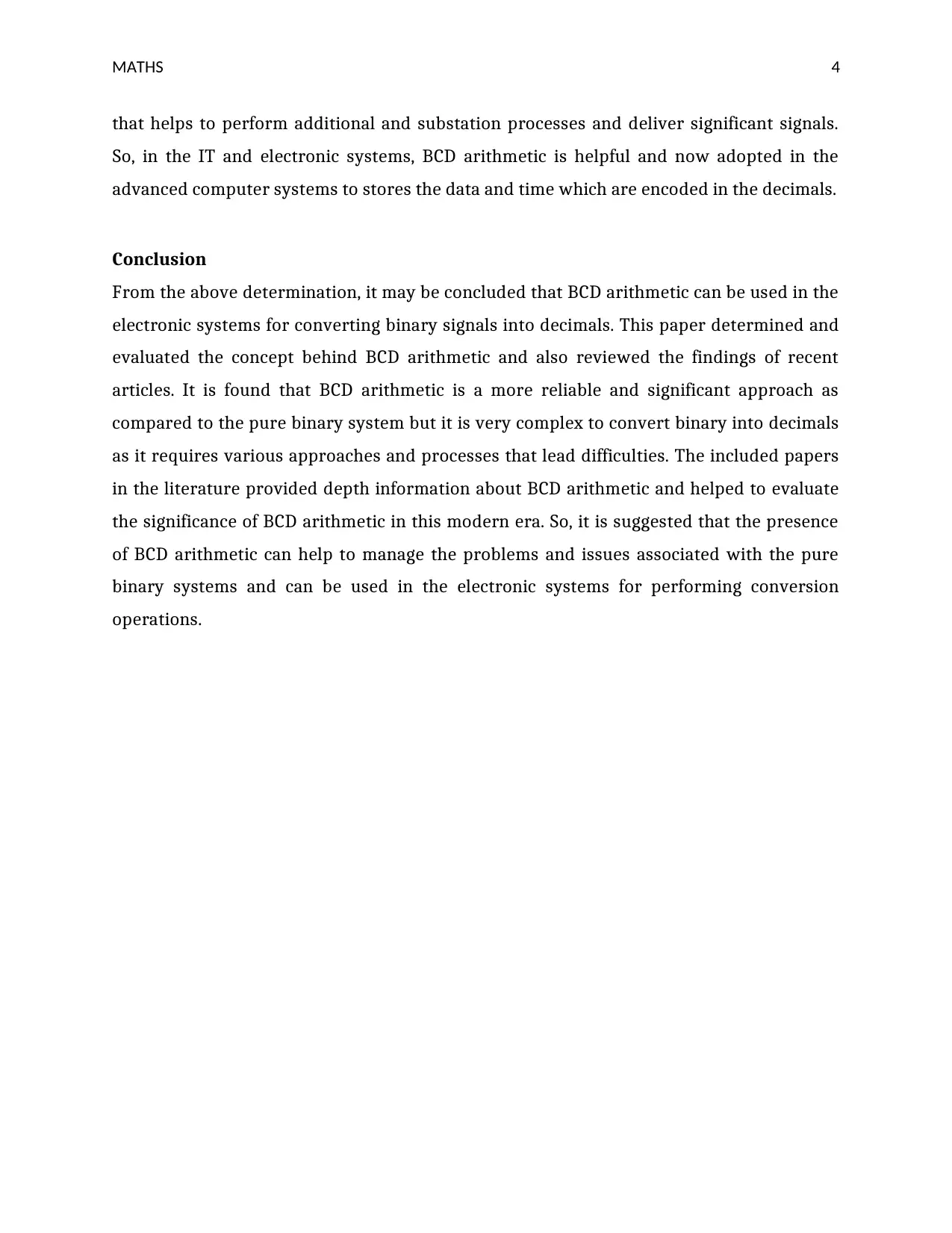
MATHS 4
that helps to perform additional and substation processes and deliver significant signals.
So, in the IT and electronic systems, BCD arithmetic is helpful and now adopted in the
advanced computer systems to stores the data and time which are encoded in the decimals.
Conclusion
From the above determination, it may be concluded that BCD arithmetic can be used in the
electronic systems for converting binary signals into decimals. This paper determined and
evaluated the concept behind BCD arithmetic and also reviewed the findings of recent
articles. It is found that BCD arithmetic is a more reliable and significant approach as
compared to the pure binary system but it is very complex to convert binary into decimals
as it requires various approaches and processes that lead difficulties. The included papers
in the literature provided depth information about BCD arithmetic and helped to evaluate
the significance of BCD arithmetic in this modern era. So, it is suggested that the presence
of BCD arithmetic can help to manage the problems and issues associated with the pure
binary systems and can be used in the electronic systems for performing conversion
operations.
that helps to perform additional and substation processes and deliver significant signals.
So, in the IT and electronic systems, BCD arithmetic is helpful and now adopted in the
advanced computer systems to stores the data and time which are encoded in the decimals.
Conclusion
From the above determination, it may be concluded that BCD arithmetic can be used in the
electronic systems for converting binary signals into decimals. This paper determined and
evaluated the concept behind BCD arithmetic and also reviewed the findings of recent
articles. It is found that BCD arithmetic is a more reliable and significant approach as
compared to the pure binary system but it is very complex to convert binary into decimals
as it requires various approaches and processes that lead difficulties. The included papers
in the literature provided depth information about BCD arithmetic and helped to evaluate
the significance of BCD arithmetic in this modern era. So, it is suggested that the presence
of BCD arithmetic can help to manage the problems and issues associated with the pure
binary systems and can be used in the electronic systems for performing conversion
operations.
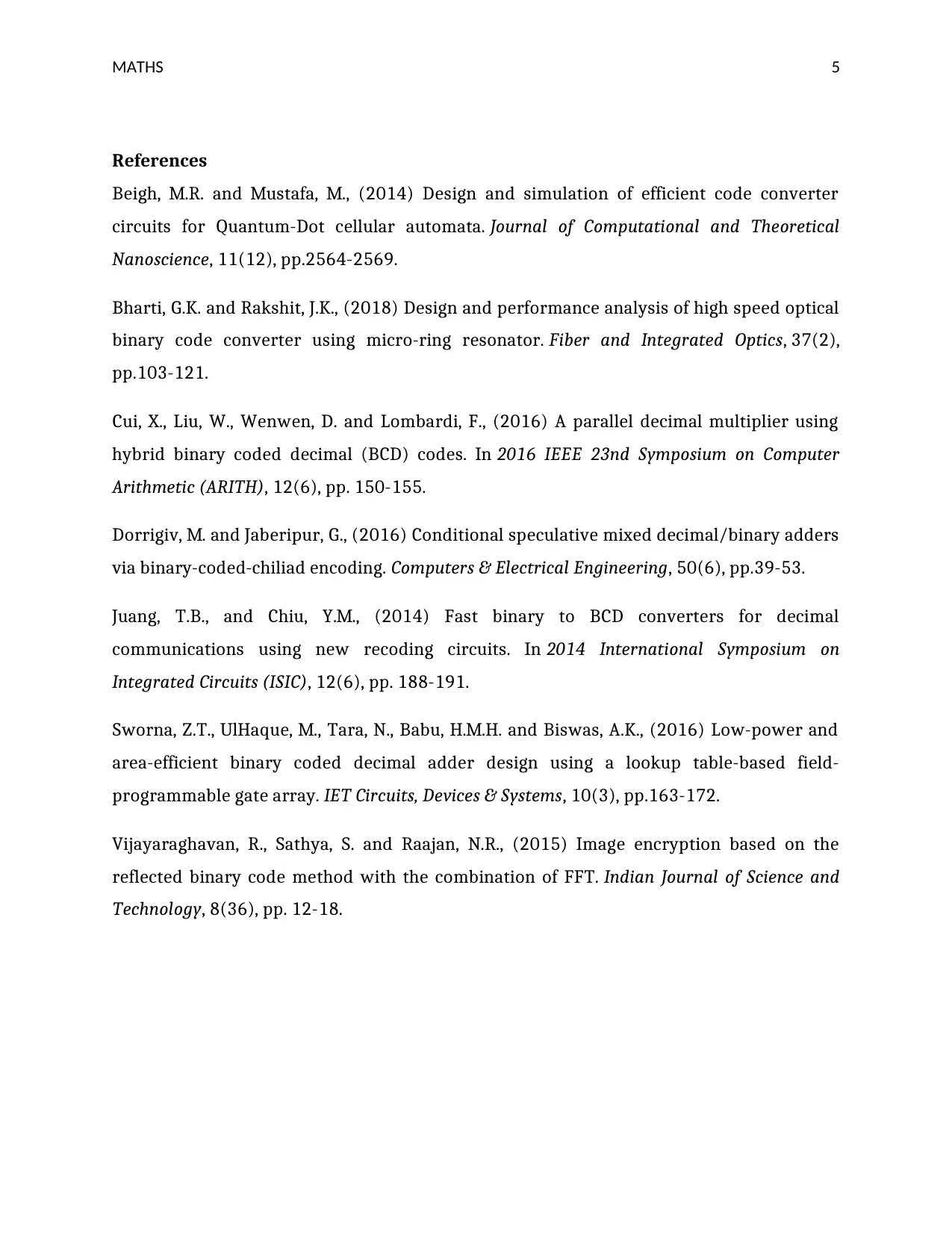
MATHS 5
References
Beigh, M.R. and Mustafa, M., (2014) Design and simulation of efficient code converter
circuits for Quantum-Dot cellular automata. Journal of Computational and Theoretical
Nanoscience, 11(12), pp.2564-2569.
Bharti, G.K. and Rakshit, J.K., (2018) Design and performance analysis of high speed optical
binary code converter using micro-ring resonator. Fiber and Integrated Optics, 37(2),
pp.103-121.
Cui, X., Liu, W., Wenwen, D. and Lombardi, F., (2016) A parallel decimal multiplier using
hybrid binary coded decimal (BCD) codes. In 2016 IEEE 23nd Symposium on Computer
Arithmetic (ARITH), 12(6), pp. 150-155.
Dorrigiv, M. and Jaberipur, G., (2016) Conditional speculative mixed decimal/binary adders
via binary-coded-chiliad encoding. Computers & Electrical Engineering, 50(6), pp.39-53.
Juang, T.B., and Chiu, Y.M., (2014) Fast binary to BCD converters for decimal
communications using new recoding circuits. In 2014 International Symposium on
Integrated Circuits (ISIC), 12(6), pp. 188-191.
Sworna, Z.T., UlHaque, M., Tara, N., Babu, H.M.H. and Biswas, A.K., (2016) Low-power and
area-efficient binary coded decimal adder design using a lookup table-based field-
programmable gate array. IET Circuits, Devices & Systems, 10(3), pp.163-172.
Vijayaraghavan, R., Sathya, S. and Raajan, N.R., (2015) Image encryption based on the
reflected binary code method with the combination of FFT. Indian Journal of Science and
Technology, 8(36), pp. 12-18.
References
Beigh, M.R. and Mustafa, M., (2014) Design and simulation of efficient code converter
circuits for Quantum-Dot cellular automata. Journal of Computational and Theoretical
Nanoscience, 11(12), pp.2564-2569.
Bharti, G.K. and Rakshit, J.K., (2018) Design and performance analysis of high speed optical
binary code converter using micro-ring resonator. Fiber and Integrated Optics, 37(2),
pp.103-121.
Cui, X., Liu, W., Wenwen, D. and Lombardi, F., (2016) A parallel decimal multiplier using
hybrid binary coded decimal (BCD) codes. In 2016 IEEE 23nd Symposium on Computer
Arithmetic (ARITH), 12(6), pp. 150-155.
Dorrigiv, M. and Jaberipur, G., (2016) Conditional speculative mixed decimal/binary adders
via binary-coded-chiliad encoding. Computers & Electrical Engineering, 50(6), pp.39-53.
Juang, T.B., and Chiu, Y.M., (2014) Fast binary to BCD converters for decimal
communications using new recoding circuits. In 2014 International Symposium on
Integrated Circuits (ISIC), 12(6), pp. 188-191.
Sworna, Z.T., UlHaque, M., Tara, N., Babu, H.M.H. and Biswas, A.K., (2016) Low-power and
area-efficient binary coded decimal adder design using a lookup table-based field-
programmable gate array. IET Circuits, Devices & Systems, 10(3), pp.163-172.
Vijayaraghavan, R., Sathya, S. and Raajan, N.R., (2015) Image encryption based on the
reflected binary code method with the combination of FFT. Indian Journal of Science and
Technology, 8(36), pp. 12-18.
1 out of 6
Your All-in-One AI-Powered Toolkit for Academic Success.
+13062052269
info@desklib.com
Available 24*7 on WhatsApp / Email
![[object Object]](/_next/static/media/star-bottom.7253800d.svg)
Unlock your academic potential
© 2024 | Zucol Services PVT LTD | All rights reserved.

